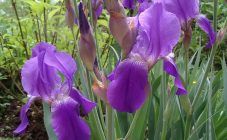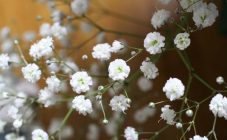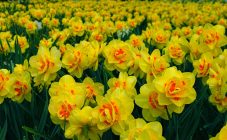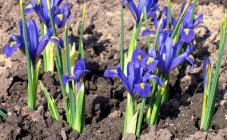Content:
As a flower, iris has been known since ancient Greece. One of the frescoes found in temples and palaces on the island of Crete depicts a priest surrounded by irises. These wall paintings are approximately 4000 years old. Translated from Greek, iris means "rainbow", it was through it that the goddess Iris came to earth to people. Her airy, dew-droplet robes shimmered with all colors. It was in her honor that the plant was named, which in one flower can have up to 5-6 shades. One of the legends says that once a rainbow, before disappearing, crumbled into fragments, and beautiful irises bloomed where they fell.
In the Middle Ages, irises were mainly grown in monasteries and churches, from where they began to spread to the gardens of ordinary people.
Description
Iris belongs to the genus Iris and is a perennial rhizome plant. It is found in all countries of the world and has more than 800 species, distinguished by a rich palette of colors and shapes.
The root system of the plant is located shallow, in the upper layer of the earth. The leaves are flat, xiphoid, fan-shaped. The flower consists of 3 outer petals (fouls), bent down, and 3 upper (standard), more or less connected at the top. At the base, the petals grow together into a tube containing nectar. Are bee-pollinated. Sometimes killer whales are called northern orchids for their delicate aroma, variety and perfect flower shape.
In Russia they bloom from May to July, are winter-hardy and are rather unpretentious plants, but they do not like waterlogging and clay soils. In nature, irises easily interbreed with each other, which made it possible to breed many new species in a short time. More than 1000 varieties of this plant are currently known. There are a lot of classifications of irises, but for non-professionals they are simplified and divided into bearded and non-bearded.
Characteristic
In the description of the varieties of bearded men it is indicated that they all have large flowers, corrugated, lacy, exuding a delicate aroma. They are classified into:
- undersized, the height of which does not exceed 40 cm;
- medium-sized, sizes from 40 to 70 cm;
- tall from 70 cm in height.
If you wish, you can choose varieties of iris in such a way that flowering plants will delight the eye for 2 months. The very first to bloom are dwarf irises, having a low peduncle and fairly large flowers. Suitable for making rockeries. The flowering period of one flower is 4-5 days, but due to the fact that there are several of them on the peduncle, you can admire the plant for more than 10 days. Then comes the turn of medium-sized irises, which were bred by crossing dwarfs and tall plants. And the last to bloom are tall irises. They acquired this appearance about 100 years ago as a result of crossing the variegated iris and the pale iris with the Asian Minor bearded irises. The resulting Germanic varieties became the basis of all later bred bearded varieties. A little later, leafless iris was included in the breeding work, which gave the flowers rich purple and black colors.
The bearded Iris can withstand both drought and frost. It successfully winters under the snow; in the absence of such a cover, it can be covered with lutrasil, pine or spruce branches for the winter.
Varieties
Many fans of bearded irises live in Russia. The best varieties for breeding:
- Iris Louise Song (Louisas Song). Belongs to the mid-early flowering group. Peduncle height reaches 105 cm. Standards are lilac, purple-red, lower petals with an orange beard.
- Iris Supreme Sultan (Sultan). Until recently, it was considered the largest owner of two-colored flowers. The upper lobes are yellow, the lower ones are laced, dark red, about 20 cm in size.
- Iris Copatonic (Copatonic). Owner of velvet mustard brown flowers. It is popular because of its unusual color both among domestic iris growers and abroad.
- Iris Decadence. It appeared at the beginning of the XXI century, has strongly lace flowers. Bred by an Australian breeder. The height of the peduncle of the Decadence iris reaches 96 cm. It belongs to medium-flowering plants. Standards - apricot with yellowness around the edges, fouls - purple in the middle, lighter towards the edges.
- Iris Wabash. Refers to Germanic tall two-tone irises. Peduncles up to 90 cm high. The upper petals are white, the lower ones are lilac or violet with a white border, unusually delicate, golden beard. The bearded Wabash is one of the first to bloom.
- Iris Rimfire. Peduncle about 90 cm high. Blooms in June-July. The flower is about 14 cm in diameter. Standards are orange, fouls are red with a white spot.
- Iris Brown Lasso. Peduncle height - 60-80 cm. Blossoms in May-June. It has a delicate sweet aroma. Bearded Brown Lasso almost does not suffer from insect pests, is resistant to drought. The upper petals have a bright yellow color, the lower ones have golden brown borders, the middle with a blue tint.
- Iris Edith Wolford (Edith Wolford). Peduncle about 60-70 cm high. Looks great on flower beds next to other garden flowers. The size of the flower is about 15 cm. The upper petals are strongly corrugated yellow, the lower ones are blue. The plant has a delicate sweet aroma. Blooms from May to June. The flowering period lasts about 4 weeks. For good flowering, Edith Walford's iris needs a sunny site for planting. In partial shade, limits the number of colors. Winter-hardy, almost not damaged by pests.
- Iris Lovely Senorita. Refers to tall bearded men. Peduncle height - up to 105 cm. Standards - copper-red, fouls - orange-brown, amber-colored beard. The stems can withstand 10-15 buds.
- Iris Dandy Candy. The height of this bearded man reaches 80 cm. The flowering period is mid-late. The flower has a sweet scent. Standards - purple, pale peach fouls with purple border. The beard is orange.
- Iris Red Singer. This bright flower blooms from May to June. The height of the peduncles is from 60 to 80 cm. It stands well in a bouquet and will delight you with a fresh look for 5-10 days. The flowers reach 15 cm in diameter and have a bright burgundy color and a copper-yellow beard.
- Iris High Master (High Master). It is considered to be a super corrugated variety. Because of this and because of the unusual color, it is inaccessible at a price for ordinary florists. The upper petals are lemon-colored, the lower ones are pinkish-crimson with a lemon border and a yellow beard. There is a pearlescent coating throughout the flower. Blooms in June-July. Peduncle 90 cm high.
- Iris Just Crazy. It has a highly corrugated flower. Peduncle height - 91 cm. Refers to mid-early varieties. The aroma is musky. Standards are apricot in color, fouls are dark apricot, with brown stripes extending from the goatee. The beard is bright orange.
- Iris Romantic Gentleman. It is considered a super variety. A tall, bearded vulture of the early-middle flowering period with a pronounced sweet aroma.The upper petals are pink, turning into burgundy, the lower ones are burgundy in the middle, to the edge - dark pink, strongly corrugated. The beard is light tangerine.
- Iris Black Knight. Tall plant (up to 1 m), attractive in size and color. The flowers are large, bluish-black. Due to its strict color, it is in demand in the design of flower beds, blooms in May for 10-15 days.
- Iris Fashion Diva. Considered a super corrugated variety, it has a musky aroma. Plant height - 97 cm. Standards - from pink to crimson on one petal, fouls - from cherry to purple with light veins from an orange beard.
- Iris Full Figured (Full Figared, or Full Figard). Peduncle height - up to 90 cm. Average flowering period. Standards - white and lilac, red grape fouls with an orange beard.
- Iris Celebration Song (Celebration Song). Refers to tall bearded men. The flowers are pinkish apricot with an orange beard.
- Iris Glamor Pence (Glamor Pants). Tall corrugated early flowering variety. Standards - apricot with a gold border, dark red fouls.
- Iris Mandarin Morning (Mandarin Moning). One of the earliest tall varieties. A flower with a light beige top and pinkish coffee lower petals.
- Iris Chasing Rainbows (Chasing Rainbow). Peduncle height - 81 cm, average flowering time. The upper petals are pinkish-peach, the lower ones are blue-violet.
- Iris Golden Panther (Golden Panther). It has a bright orange flower.
- Iris Sapphire Gem. A dwarf bearded man about 35 cm in size. Flowers are deep blue with a white beard.
- Iris Romantic Evening. Medium-late flowering. The standards are lilac, the fouls are reddish-black.
- Iris Loop de Loop (bearded Loop ze Loop). The petals are white with a blue-violet border. Blooms in May-June.
- Iris Snowy. The standards are snow-white with a thin burgundy outline, deep purple fouls. It has an extended flowering cycle, from June to September.
- Iris Role Model. The flowers have berry shades in color, have a strong musk smell.
- Iris Crinoline. Tall plant, reaches 120 cm. It has a burgundy flower with a white spot in the middle. The bearded Crinoline blooms in June.
Breeding, planting and grooming
A bearded man needs a warm, sunny open place to grow, he does not tolerate stagnant water. A sufficient amount of sand must be added to clay soil for better moisture permeability; vermicompost or rotted compost can be used.
One-year rhizome growth is considered the best for reproduction. Usually, irises reach sizes suitable for dividing rhizomes by August, when there are no more flowers on the plant, and it is at this time that the transplantation and division of the bushes is recommended. If flowering is required the next year, then there should be at least 7 leaves in the fan. And if it is important that the cut survive the winter well, you can root a small rhizome 2-2.5 cm long and with 3-4 leaves. The plant will not bloom next year, but it will take root well in the new flower garden.
A flower cannot grow in one place for more than 4 years. For rejuvenation and breeding, the following manipulations should be performed:
- Dig up the bush.
- Break out the faded peduncles - you need to slightly tilt the peduncle and it will easily be removed.
- Divide the bush with a sharp shovel.
- Trim the leaves, leaving about 15 cm.
- Sprinkle cuts with ash.
- Prune long roots as new young ones will soon grow.
The roots should be buried in the ground no more than 2-4 cm, the growth point should be above the surface. Cover with earth and tamp on top. Watering is required for fast rooting. Leave the distance between plants about 40-50 cm.
Sometimes you have to plant bearded irises in spring or early summer after buying in the market, when the plant blooms. This is not a good time to root, but it is possible. Delenki received by mail in the spring often have dried roots, this should not scare the buyer.The material is planted in the ground, watering it regularly, new roots will begin to grow, and the plant will throw out leaves.
Caring for plants consists of:
- watering during hot spring, however, excess moisture can provoke fungal diseases;
- loosening - since the roots are superficial, care must be taken;
- top dressing.
The main diseases and pests, methods of dealing with them
In humid regions, flowers suffer from various bacterial diseases. It is easy to identify the disease - the roots become soft, an unpleasant odor appears. If a large area of roots is affected, the plant must be burned to avoid spreading the infection, and the flowers nearby should be transplanted. If it is found that the roots are slightly infected with rot, it is necessary to cut off the diseased area to healthy tissue with a knife dipped in a strong solution of potassium permanganate. In the same solution, immerse the cut rhizomes for 1-2 hours, if the variety is expensive and you want to keep it. After that, roll in ash and dry in the shade for several days. Before planting the plant, you need to make a shallow but wide hole, preferably with a sandy mound in the middle, so that the roots can freely lie on the ground, and add Fitosporin to the water for irrigation to protect against fungal diseases.
If you overdo it with manure, wet rot may appear. To prevent its spread, the rhizomes are treated with a solution of potassium permanganate before planting. For a 0.5 liter jar, take ½ tsp. KMnO4 and immersed in the rhizome solution for 30 minutes. To prevent these diseases, plants are sprayed with fungicides.
Flowers can be annoyed by thrips. In this case, they are treated with fufanol. A 10% solution is prepared and the plant is treated.
Iris amazes with its beauty and range of colors. With proper care and attention, it becomes the central decoration of flower beds and pleases its owners with long flowering.















